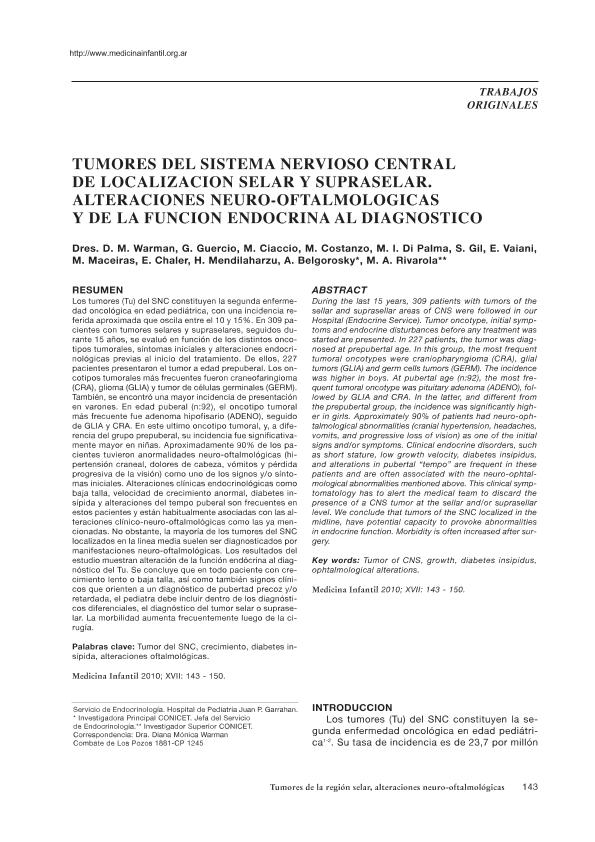Artículo
Los tumores del SNC constituyen la segunda enfermedad oncológica en edad pediátrica, con una incidencia referida aproximada que oscila entre el 10 y 15 %. La ubicación es selar-supraselar. En 309 pacientes con tumores selares y supraselares, seguidos durante 15 años, se evaluó en función de los distintos oncotipos tumorales, síntomas iniciales y alteraciones endocrinológicas previas al inicio del tratamiento. De ellos, 227 pacientes presentaron el tumor a edad prepuberal. Los oncotipos tumorales más frecuentes fueron craneofaringioma (CRA), glioma (GLIA) y tumor de células germinales (GERM). También, se encontró una mayor incidencia de presentación en varones. En edad puberal (n:92), el oncotipo tumoral más frecuente fue adenoma (ADENO), seguido de GLIA y CRA. En este ultimo oncotipo tumoral, y, a diferencia del grupo prepuberal, su incidencia fue significativamente mayor en niñas. Aproximadamente 90% de los pacientes tuvieron anormalidades neuro-oftalmológicas (hipertensión craneal, dolores de cabeza, vómitos y pérdida progresiva de la visión) como uno de los signos iniciales y/o síntomas. Alteraciones clínicas endocrinológicas como baja talla, velocidad de crecimiento anormal, diabetes insípida y alteraciones del tempo puberal son frecuentes en estos pacientes y están frecuentemente asociados con las alteraciones clínico-neuro-oftalmológicas como los ya mencionadas. No obstante, la mayoría de los tumores del SNC localizados en la línea media suelen ser diagnosticados por manifestaciones neuro-oftalmológicas. Los resultados del estudio muestran alteración de la función endócrina al diagnostico del Tu. Se concluye que en todo paciente con crecimiento lento o baja talla, así como también signos clínicos que orienten a un diagnóstico de pubertad precoz y/o retardada debe alertar al pediatra de incluir dentro de los diagnósticos diferenciales, el diagnóstico del tumor selar o supraselar. La morbilidad aumenta frecuentemente luego de la cirugía. During the last 15 years, 309 patients with tumors of the sellar and suprasellar areas of CNS were followed in our Hospital (Endocrine Service). Tumor oncotype, initial symptoms and endocrine disturbances before any treatment was started are presented. In 227 patients, the tumor was diagnosed at prepubertal age. In this group, the most frequent tumoral oncotypes were craniopharyngioma (CRA), glial tumors (GLIA) and germ cells tumors (GERM). The incidence was higher in boys. At pubertal age (n:92), the most frequent tumoral oncotype was pituitary adenoma (ADENO), followed by GLIA and CRA. In the latter, and different from the prepubertal group, the incidence was significantly higher in girls. Approximately 90% of patients had neuro-ophtalmological abnormalities (cranial hypertension, headaches, vomits, and progressive loss of vision) as one of the initial signs and/or symptoms. Clinical endocrine disorders, such as short stature, low growth velocity, diabetes insipidus, and alterations in pubertal “tempo” are frequent in these patients and are often associated with the neuro-ophtalmological abnormalities mentioned above. This clinical symptomatology has to alert the medical team to discard the presence of a CNS tumor at the sellar and/or suprasellar level. We conclude that tumors of the SNC localized in the midline, have potential capacity to provoke abnormalities in endocrine function. Morbidity is often increased after surgery.
Tumores del sistema nervioso central de localización selar y supraselar. Alteraciones neuro-oftalmológicas y de la función endócrina al diagnóstico
Warman, M.; Guercio, G.; Ciaccio, M.; Costanzo, M.; Di Palma, M. I.; Vaiani, E.; Maceiras, M.; Chaler, E.; Mendilaharzu, H.; Belgorosky, Alicia ; Rivarola, Marco Aurelio
; Rivarola, Marco Aurelio
 ; Rivarola, Marco Aurelio
; Rivarola, Marco Aurelio
Fecha de publicación:
06/2010
Editorial:
Fundación Hospital de Pediatría Garrahan
Revista:
Medicina Infantil
ISSN:
0328-0160
Idioma:
Español
Tipo de recurso:
Artículo publicado
Clasificación temática:
Resumen
Archivos asociados
Licencia
Identificadores
Colecciones
Articulos(SEDE CENTRAL)
Articulos de SEDE CENTRAL
Articulos de SEDE CENTRAL
Citación
Warman, M.; Guercio, G.; Ciaccio, M.; Costanzo, M.; Di Palma, M. I.; et al.; Tumores del sistema nervioso central de localización selar y supraselar. Alteraciones neuro-oftalmológicas y de la función endócrina al diagnóstico; Fundación Hospital de Pediatría Garrahan; Medicina Infantil; 17; 2; 6-2010; 143-150
Compartir



